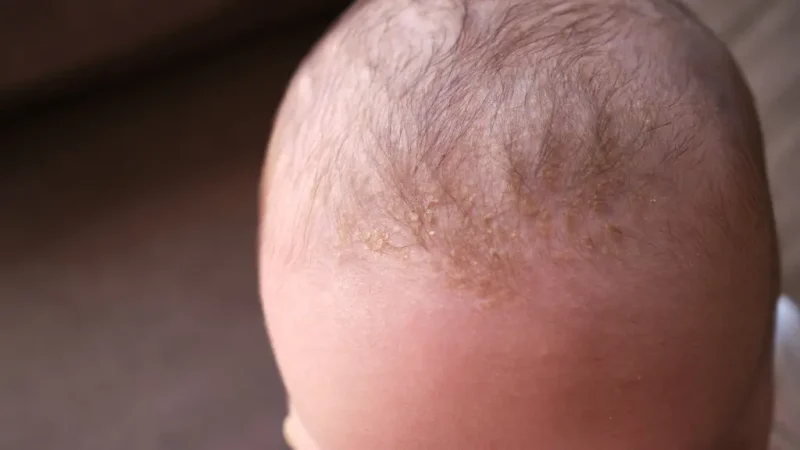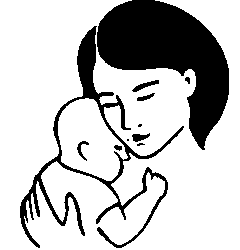As a new parent, you may be alarmed to notice your baby’s head skin starting to peel. This common skin condition, known as seborrheic dermatitis or “cradle cap,” is a normal part of your little one’s development.
Babies can develop seborrheic dermatitis between 2 weeks and 12 months old. It usually starts with cradle cap—slightly red, scaly, or crusty yellow patches on the scalp. The condition may also spread to the face or diaper area.

While the appearance of a cradle cap can be concerning, it is generally not a painful or itchy condition for most babies.
In this article, we’ll dive deeper into the causes, symptoms, and treatment options for seborrheic dermatitis in infants.
Why is My Baby’s Head Skin Peeling?
Babies can develop seborrheic dermatitis, also known as “cradle cap,” between 2 weeks and 12 months old. This common skin condition is characterized by the appearance of slightly red, scaly, or crusty yellow patches on the scalp, which may also spread to the face or diaper area.
The primary reason for a baby’s head skin peeling is the overproduction of skin oils, called sebum, combined with a type of yeast called Malassezia that can overgrow on the skin.
This excess oil and yeast buildup leads to the formation of the characteristic scaly, crusty patches associated with cradle caps.
Additionally, the hormonal changes that occur in the first few months of a baby’s life can also contribute to the development of seborrheic dermatitis.
In some cases, dry skin can also be a factor, as the body tries to compensate by producing more oil.
While the peeling and scaling appearance of cradle caps can be concerning for parents, they are generally not painful or itchy for most babies.
With proper care and treatment, seborrheic dermatitis typically resolves on its own within the first few months of a baby’s life.
What is Seborrheic Dermatitis?
Seborrheic dermatitis, also known as cradle cap, is a common skin condition that affects many infants.
It’s characterized by the presence of scaly, oily, or crusty patches on the scalp, face, or other areas of the body.
This condition is typically not a cause for concern and is often a regular part of a baby’s skin development.
Causes of Seborrheic Dermatitis in Babies
There are a few factors that can contribute to the development of seborrheic dermatitis in babies:
- Overproduction of Skin Oils: Babies’ skin glands produce more oil, called sebum, than older children and adults. This excess oil can lead to the buildup of dead skin cells, resulting in the characteristic scaly patches.
- Fungal Infection: A type of yeast called Malassezia can overgrow on the skin, leading to inflammation and the formation of a cradle cap.
- Hormonal Changes: The hormonal changes that occur during the first few months of life can also play a role in the development of seborrheic dermatitis.
- Dry Skin: In some cases, dry skin can contribute to the development of a cradle cap, as the body tries to compensate by producing more oil.
Symptoms of Seborrheic Dermatitis in Babies
The most common symptom of seborrheic dermatitis in babies is the appearance of scaly, crusty, or greasy patches on the scalp, known as cradle caps.
These patches may be yellow, white, or even reddish. In some cases, the condition may also appear on the face, eyebrows, eyelids, ears, or even the diaper area.
It’s important to note that while the appearance of a cradle cap can be unsightly, it is generally not a painful or itchy condition for most babies.
Diagnosing Seborrheic Dermatitis in Babies
If you notice your baby’s head skin peeling, consult your pediatrician.
They will be able to examine your baby’s skin and provide a diagnosis. In most cases, a visual examination is enough to identify seborrheic dermatitis, but your doctor may also perform additional tests if necessary.
Treating Seborrheic Dermatitis in Babies
The good news is that seborrheic dermatitis in babies is typically a temporary condition that resolves on its own within the first few months of life.
However, some treatment options can help manage the symptoms and provide relief:
- Gentle Washing: Use a mild, fragrance-free baby shampoo or cleanser to wash your baby’s scalp gently. Avoid scrubbing the affected areas, as this can worsen the condition.
- Moisturizing: Apply a small amount of a gentle, fragrance-free moisturizer to the affected areas to help soothe the skin and prevent dryness.
- Medicated Creams or Ointments: In some cases, your pediatrician may recommend the use of a medicated cream or ointment containing ingredients like hydrocortisone or antifungal agents to help manage the condition.
- Removal of Cradle Cap: Gently brushing or combing the affected areas with a soft-bristled brush or comb can help remove the flaky, scaly patches of the cradle cap.
It’s important to note that while these treatments can help manage the symptoms of seborrheic dermatitis, the condition will generally resolve on its own as your baby’s skin matures and its hormones stabilize.
Preventing Seborrheic Dermatitis in Babies
While you can’t always prevent seborrheic dermatitis, there are some steps you can take to help reduce the risk of your baby developing the condition:
- Gentle Cleansing: Use a mild, fragrance-free baby shampoo and avoid over-washing your baby’s scalp.
- Moisturizing: Regularly apply a gentle, fragrance-free moisturizer to your baby’s skin to help prevent dryness and protect the skin barrier.
- Minimizing Stress: While stress is not a direct cause of seborrheic dermatitis, it can exacerbate the condition. Try to maintain a calm and soothing environment for your baby.
- Consulting with Your Pediatrician: If you have any concerns about your baby’s skin health, don’t hesitate to speak with your pediatrician. They can provide guidance and personalized recommendations to help manage and prevent seborrheic dermatitis.
Conclusion
Seborrheic dermatitis, or cradle cap, is a common and often harmless skin condition that affects many infants.
While it can be concerning to see your baby’s head skin peeling, it’s important to remember that this is a normal part of their skin development and typically resolves on its own within the first few months of life.
By understanding the causes, symptoms, and treatment options for seborrheic dermatitis, you can help keep your little one comfortable and confident in their skin.
Remember, every baby is unique, so be sure to work closely with your pediatrician to find the best approach for your family.
Is it normal for a baby’s head skin to peel?
Yes, it is quite normal for a baby’s head skin to peel, especially in the first year of life. This is often due to a common skin condition called seborrheic dermatitis, or “cradle cap.” Cradle cap is characterized by the appearance of scaly, oily, or crusty yellow patches on the scalp and is caused by an overproduction of skin oils and a type of yeast called Malassezia. Hormonal changes in infants can also contribute to the development of cradle caps. While the peeling and scaling may appear concerning, it is generally not a painful or itchy condition for most babies.
How long does it take for a baby’s cradle cap to go away?
In most cases, the cradle cap will resolve on its own within the first few months of a baby’s life. Seborrheic dermatitis, the underlying condition that causes cradle cap, is a normal part of an infant’s skin development. It typically clears up as the baby’s hormones stabilize and their skin matures. While treatment options like gentle washing, moisturizing, and sometimes medicated creams can help manage the symptoms, the condition will generally go away without any long-term effects. Most babies outgrow cradle caps by the time they reach 6-12 months of age.

1 thought on “Why is My Baby’s Head Skin Peeling? A Friendly Guide for Concerned Parents”